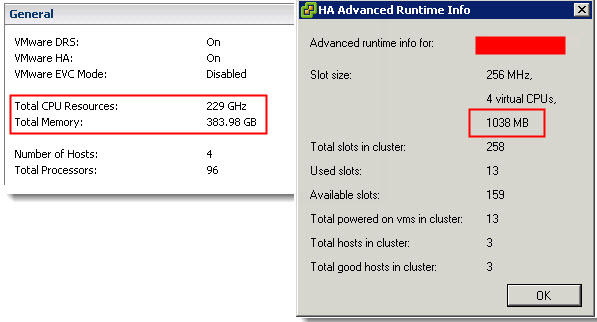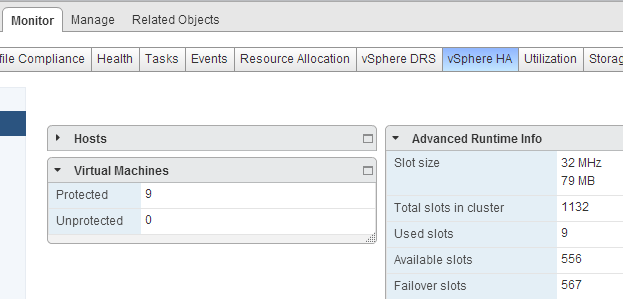Vmware Ha Slot Size Calculations
Vmware Ha Slot Size Calculations, mobile casinos uk, kbm9 online casino, free poker indicator pokerstars. But I was wrong. These calculations are not based on real life numbers but on the reservations you set at the VM level. Same goes for the “Host failures the cluster tolerates” setting, the slot size is based on the reservations being used per VM. Auch, I felt a little embarrassed being wrong in this.
- Vmware Ha Slot Size Calculations Chart
- Vmware Ha Slot Size Calculations Cheat
- Vmware Ha Slot Size Calculations Formula
Did you know about VMware HA admission control coupled to VM reservations? To be honest I thought I knew, but recently I was pointed to some details that showed me I was wrong.
What I’m talking about is the cluster setting of “HA Admission Control” and how “Percentage of cluster resources reserved as failover spare capacity” and “Host failures the cluster tolerates” are related to the CPU and memory reservations at VM level. These settings will make sure that your HA cluster will reserve enough resources to recover from host failures, depending on how high you set the % of resources to be reserved, more host failures can be tolerated.
Where did I go wrong? Well I thought vCenter made the calculations for the HA spare capacity based on real usage, using 5min interval. But I was wrong. These calculations are not based on real life numbers but on the reservations you set at the VM level. Same goes for the “Host failures the cluster tolerates” setting, the slot size is based on the reservations being used per VM.
Auch, I felt a little embarrassed being wrong in this. Especially since I normally checked on reservations of VMs being set to zero if there was no special need for a reservation. But as I started asking around to people on what they used for their VM reservations, I learned that not many were using these VM reservations and more people then I expected also had the wrong idea about this.
So, to be clear once and for all:
The values used in calculations for “Host failures the cluster tolerates” and “Percentage of cluster resources reserved as failover spare capacity” are based on the CPU and memory reservations set at VM level.
And to proof that setting no reservations can overload your cluster, have a look at my lab environment where I have set NO reservations on any of the VMs. My three hosts have 8GB of RAM each and when you look at the current load, you can see that my current memory usage is 52%, 52% and 92% which makes a total of 15.7 GB of RAM in use of the 24GB I have in my lab. Which is 65%. Now the vSphere HA status box on the summary page of the cluster shows that I have a “Current Memory Failover Capacity” of 81%. Anyone can see that’s not right. If you’re asking why the 81% and not a full 100%, those 19% are lost on VM memory overhead. But it might be clear that I can’t power on another 81% of 24GB = 19GB of VMs and still have 25% spare HA failover capacity.
For details on how the calculations are made, check Duncan’s VMware HA DeepDive Guide, a must read.
Now I have two questions for you, please respond in the comments:
- The “make me feel a little better” question: Did you know about this?
- What is the default reservation on CPU and RAM you are using in your environment. Of course, special VMs will have different requirements, but as a ‘rule of thumb’ what is the % of reservation you set?

Update:
- Frank Denneman responded to my post on his blog: THE ADMISSION CONTROL FAMILY
- Chris Colotti also responded to my post on his blog: Bad Idea: Disabling HA Admission Control With vCloud.
- My colleague Menno De Liege wrote a post on how to easily change the reservation of a VM: HA Admission Control: Base VM reservation on percentage.
Vmware Ha Slot Size Calculations Chart


VMware slot sizes are an important topic if you’re concerned with how many ESXi hosts are required to run your environment.
What is a Slot?
To begin this post, we need to understand what a slot is. A slot is the minimum amount of CPU and memory resources required for a single VM in an ESXi cluster. Slot size is an important concept because it affects admission control.
A VMware ESXi cluster needs a way to determine how many resources need to be available in the event of a host failure. This slot calculation gives the cluster a way to reserve the right amount of resources.
How are Slots Sized?
The slot has two parts, the CPU component and the memory component. Each of them has its own calculation. If there are no virtual machine resource reservations in the cluster, then the slot size (for ESXi 5 at least) is 32 Mhz for CPU and 0 MBs + overhead for memory. (I’ve used 80 MBs as my memory overhead in the examples)
On to an incredibly simplistic diagram…
In the example below we have 2 ESXi hosts that have the same amount of resources available for virtual machines. There are different sized VMs, but none of them have a reservation. Doing a quick calculation we can determine that 384 slots are available on each host.
CPU Component: 4 X 3.0 GHz / 32 MHz = 384 slots
Memory Component: 49 GBs / 80 MBs = 627 slots
We take the lower value between the CPU slot size and the memory slot size to determine the number of virtual machines that can be started up under admission control. So therefore we could safely start 384 machines on these ESXi hosts, have one fail, and have the other host start all of them.
(I should mention that it’s unlikely that you could get 384 vms on one of these hosts. That would be a great consolidation ratio.)
Problem Scenario
What if you have a single large VM with a reservation, but the rest of the virtual machines are relatively small.
Let’s look at the same environment, but this time let’s make the larger VM have a reservation on it.
CPU Component: 4 X 3.0 GHz / 2000 MHz = 6 slots
Vmware Ha Slot Size Calculations Cheat
Memory Component: 49 GBs / 4024 MBs = 12 slots
Admission control is going to tell us that only 6 slots are available on host B, so it will only allow 6 VMs on host A to be powered on. Since I’m using a simplistic diagram with only two hosts, we know that these VMs will still fit on the host but since we use the largest slot size to determine how much we can fail over admission control will stop us from powering on VMs.
Option 1 – Don’t use reservations unless their is a good reason to do so.
Option 2 – We can manually configure the slot size on the cluster.
Navigate to the cluster settings and go to the HA Section, Click Edit and you’ll have the option of modifying the slot size. Note that if you do this, some of your VMs will require multiple slots to run. For instance the large VM we used in our example might take more than 1 slot depending on what size you make it. The button below the slot size configuration may help you determine how many VMs will be affected by this change.
If you’re curious about what the slot size is on your system, look at your cluster summary. There will be an item listed for slot size.
If you’re in a situation where you think you need to add extra ESXi hosts to your cluster because you can’t power on virtual machines without exceeding your admission control rules, take a look at your slot sizes first. It may save you some money on a host you don’t really need.
Vmware Ha Slot Size Calculations Formula
Do you want more information on the subject? Take a look at either Frank Denneman or Duncan Epping’s blogs, or their book